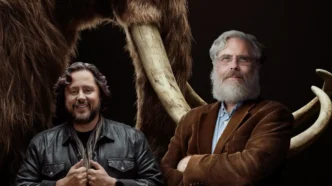Colossal Biosciences has just unveiled its boldest breakthrough yet—engineered dire wolves. Long extinct creatures that lived more than 12,000 years ago and were recently popularized by Game of Thrones. On Monday, the startup revealed three genetically modified pups that resemble these legendary animals. Marking a major step in its headline-grabbing mission to bring back extinct species.
On a secluded 2,000-acre preserve somewhere in the northern U.S., the company is raising these animals in secret. Journalists invited to witness the reveal weren’t allowed to visit the actual compound. Instead, they were flown to a separate location to meet the animals in person. A precaution that reflects a growing mistrust of digital imagery in the age of AI.
There they met Remus and Romulus, two six-month-old male pups weighing around 80 pounds each. With broad skulls and elongated snouts, they looked to the untrained eye like powerful, oversized wild dogs. A younger female pup, aptly named Khaleesi, is also part of the new pack. But Colossal insists there’s far more going on beneath the surface than what’s visible.
The creation of these dire wolf replicas stems from an 18-month genetic engineering project rooted in ancient DNA. Scientists analyzed the genome of a tooth dating back 13,000 years and a 72,000-year-old skull. From there, they compared the recovered sequences with the DNA of modern gray wolves. Discovering that the two species are about 99.5% genetically alike. Using CRISPR gene-editing tools, they modified 20 key genes associated with physical features—such as the skull and fur—then implanted the edited embryos into a large domestic dog, which gave birth to the new generation.
Colossal claims these pups represent the first time an extinct species has been re-created. The company, now valued at over $10.2 billion following its most recent fundraising round, believes this milestone puts it ahead of schedule—especially given that its mammoth and Tasmanian tiger projects weren’t expected to yield results until 2028.
Skepticism, however, still surrounds the announcement. Several scientists have voiced concerns about labeling these animals as true dire wolves. David Gold, a paleobiologist from UC Davis, noted that while the gene-editing work is impressive, the result is closer to a hybrid than a full resurrection. These pups are raised by domestic dogs and lack the behaviors or upbringing of real dire wolves, he explained. Similarly, UCLA genetics professor Alexander Young dismissed the achievement as “massively overhyped,” pointing out that the edited genome alters just 20 genes in a species that remains overwhelmingly gray wolf at the molecular level.
Even George Church, Colossal’s co-founder and a professor at both Harvard and MIT, acknowledged that only 0.3% of the gray wolf’s genes were changed. While some of those targeted internal features like skull structure, others were deliberately left untouched due to potential links with harmful mutations that could cause deafness or blindness. From an ethics standpoint, the team chose not to introduce those risks.
So are these pups truly dire wolves—or something else entirely? According to experts like Gold, it’s less a scientific debate than a philosophical one. Regardless, the question of “why dire wolves?” has an interesting backstory.
According to CEO Ben Lamm, the decision wasn’t part of the original roadmap. Once the company secured additional capital, it began exploring new species to focus on. Around that time, Colossal learned from North Carolina officials that fewer than a dozen red wolves—a critically endangered species—still existed in the wild. The team also began conversations with Indigenous groups in North Dakota who regard wolves as sacred animals. With this cultural relevance, and the support of Game of Thrones author George R.R. Martin as an adviser, the dire wolf project gained meaningful context beyond pure science.
Colossal says its mission isn’t just about spectacle. The same gene-editing technology used to build dire wolves has already been applied to clone red wolves—four so far—with more in the pipeline. The company hopes to eventually reintroduce red wolves into the wild, helping to preserve an endangered species and support biodiversity. Lamm envisions a future where Colossal not only revives lost species but also applies those advances to conservation projects globally.
As for the dire wolves, the company plans to create at least five more animals so they can form a natural pack. There are ongoing talks with Indigenous communities about possibly re-wilding them in culturally significant territories. For now, scientists and animal specialists continue to observe the pups closely, learning from their behavior, growth, and health outcomes.
Beyond the science and spectacle, there’s a practical question investors are asking: Is this really a multibillion-dollar business? Lamm believes it is, and he’s betting on several revenue streams to prove it. Colossal has already spun out two companies and plans to launch three more in the next two years, including one focused on artificial wombs—technology that could eventually find applications in fertility and neonatal care.
There’s also potential for monetizing its conservation tools. While Colossal currently offers these services to governments for free, it could one day charge for deploying its tech to help protect endangered species. Another possible revenue path lies in biodiversity credits, a concept similar to carbon credits, which would reward companies or governments for restoring or preserving ecosystems.
Whether the dire wolf becomes a symbol of scientific ambition or tech overreach remains to be seen. But one thing is clear: Colossal Biosciences is blurring the lines between science fiction and reality in a way few other startups dare to try.













